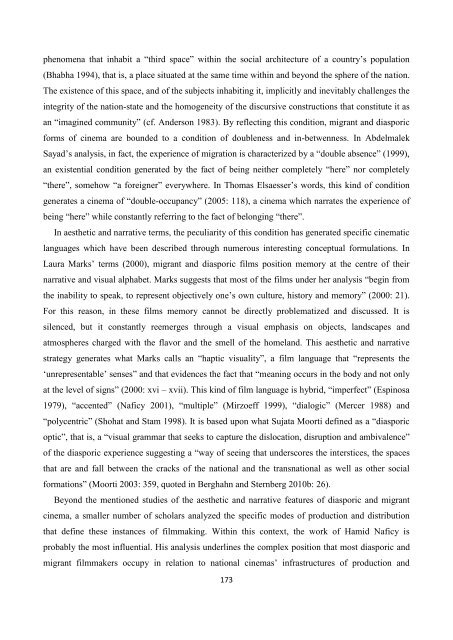You also want an ePaper? Increase the reach of your titles
YUMPU automatically turns print PDFs into web optimized ePapers that Google loves.
phenomena that inhabit a “third space” within the social architecture of a country’s population(Bhabha 1994), that is, a place situated at the same time within and beyond the sphere of the nation.The existence of this space, and of the subjects inhabiting it, implicitly and inevitably challenges theintegrity of the nation-state and the homogeneity of the discursive constructions that constitute it asan “imagined community” (cf. Anderson 1983). By reflecting this condition, migrant and diasporicforms of cinema are bounded to a condition of doubleness and in-betwenness. In AbdelmalekSayad’s analysis, in fact, the experience of migration is characterized by a “double absence” (1999),an existential condition generated by the fact of being neither completely “here” nor completely“there”, somehow “a foreigner” everywhere. In Thomas Elsaesser’s words, this kind of conditiongenerates a cinema of “double-occupancy” (2005: 118), a cinema which narrates the experience ofbeing “here” while constantly referring to the fact of belonging “there”.In aesthetic and narrative terms, the peculiarity of this condition has generated specific cinematiclanguages which have been described through numerous interesting conceptual formulations. InLaura Marks’ terms (2000), migrant and diasporic films position memory at the centre of theirnarrative and visual alphabet. Marks suggests that most of the films under her analysis “begin fromthe inability to speak, to represent objectively one’s own culture, history and memory” (2000: 21).For this reason, in these films memory cannot be directly problematized and discussed. It issilenced, but it constantly reemerges through a visual emphasis on objects, landscapes andatmospheres charged with the flavor and the smell of the homeland. This aesthetic and narrativestrategy generates what Marks calls an “haptic visuality”, a film language that “represents the‘unrepresentable’ senses” and that evidences the fact that “meaning occurs in the body and not onlyat the level of signs” (2000: xvi – xvii). This kind of film language is hybrid, “imperfect” (Espinosa1979), “accented” (Naficy 2001), “multiple” (Mirzoeff 1999), “dialogic” (Mercer 1988) and“polycentric” (Shohat and Stam 1998). It is based upon what Sujata Moorti defined as a “diasporicoptic”, that is, a “visual grammar that seeks to capture the dislocation, disruption and ambivalence”of the diasporic experience suggesting a “way of seeing that underscores the interstices, the spacesthat are and fall between the cracks of the national and the transnational as well as other socialformations” (Moorti 2003: 359, quoted in Berghahn and Sternberg 2010b: 26).Beyond the mentioned studies of the aesthetic and narrative features of diasporic and migrantcinema, a smaller number of scholars analyzed the specific modes of production and distributionthat define these instances of filmmaking. Within this context, the work of Hamid Naficy isprobably the most influential. His analysis underlines the complex position that most diasporic andmigrant filmmakers occupy in relation to national cinemas’ infrastructures of production and173
















